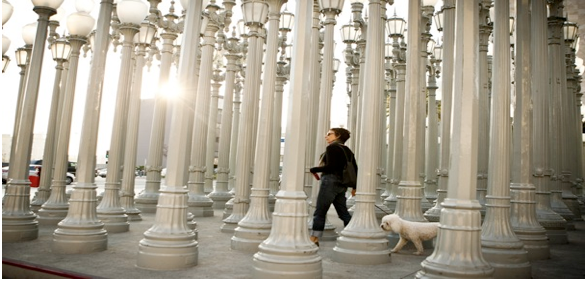GUEST WORDS - It is fitting of Los Angeles that two Angelenos of roughly the same age, who both love their hometown and care about their communities despite growing up in different corners of the City, would only meet after they had both moved back east for college, worked on Capitol Hill, and returned to California for law school.
In fact, though it remains largely unaddressed in the current mayoral race, the story of our acquaintance testifies to what we believe is Los Angeles' core challenge: that Angelenos are residents and occasionally motorists, but not citizens who share and experience a common place, co-author its destiny, and take responsibility for the city and each other.
That Angelenos are dissociated from each other, and from city government, is unsurprising: this is a city where neighbors are strangers, where City Council members each represent a quarter of a million residents, and where disparate communities often only encounter each other in the concourses and queues of Dodger Stadium. (Staples Center by contrast, with its price-segregated entrances, parking lots and pavilions, was built to accommodate and reflect Los Angeles' many cocoons.)
How can a city so fragmented ever form a self-governing unit? Some raise the question to propose secession and more fragmentation. But we believe there is a glimmer of hope: Los Angeles' system of neighborhood councils.
Innovated by the threat of secession in 1999 and based on the same federal principle that enabled a young but vast republic of thirteen former colonies to cohere into a single identified polity, neighborhood councils bridge the gap between residents and city government, provide spaces for residents to participate in and feel a tangible connection to their city, and build community by providing opportunities for neighbors to socialize, deliberate, build coalitions, and weigh-in on civic issues. In short, neighborhood councils revive local democracy as not only a decision-making process, but also a vehicle to create a sense of civic ownership, and an understanding of human relationships across affinity groups constructed through disagreement, negotiation, and compromise.
But despite their promise, neighborhood councils have been virtually absent from the city's policymaking arenas, only nominally incorporated into legislative procedure, and inconsistently noticed, much less managed, by no fewer than four general managers at the Department of Neighborhood Engagement. Moreover, those who have so far had the time and incentive to participate in neighborhood councils have been older and wealthier, frequently reducing the councils to extensions of NIMBY homeowner associations. The neglect has been so severe that today, ten years into our experiment with municipal federalism, some are prepared to abandon neighborhood councils altogether. We could not disagree more.
Instead, to give Angelenos the ability and incentive to engage with and revitalize their councils, we ask that the next mayor commit to the following.
First, to make neighborhood councils more accessible and participatory, the mayor should contract with LAUSD to provide dedicated space for neighborhood council offices at elementary schools. Creating dedicated space at familiar local schools raises awareness among community members, and makes participation more attractive for Angelenos for whom attendance at evening meetings might be impractical, or else intimidating.
Second, to attract an even larger audience, the mayor should also contract with the county and state to co-locate public programs at school sites alongside neighborhood council offices to create kiosks where Angelenos can interface with local government and access, or learn about, public services. These could include early childhood education, ESL and citizenship courses, GED programs, college readiness initiatives, and adult vocational education.
Third, the mayor should pursue initiatives that integrate neighborhood councils with the City Council. Council members should be obligated to hold monthly office hours, or stand for question time, in each of their neighborhood councils' offices, so the people can hold their representatives accountable and assert their relevance.
Fourth, to further incent community buy-in, the mayor should delegate some policy-making authority to neighborhoods. For example, the mayor should consider an ordinance that grants neighborhood councils the authority to self-assess a parcel tax on their territories for hyperlocal projects like pocket parks, street repairs, and community gardens. To prevent wealthier communities from self-funding projects this way and opting out of citywide distributive taxation in the future, some portion of what neighborhoods raise over a certain threshold would be committed to a general fund shared by all councils.
This kind of social experiment to reconstitute a dissociated urban sprawl into an integrated urban community has never been tried. But with these reforms, we are confident Los Angeles can breathe life into local institutions, shore up our communities, and transform residents into empowered citizens.
(Adam Sieff and Salvador Perez are students at Stanford Law School and native Angelenos.)
-cw
CityWatch
Vol 11 Issue 20
Pub: Mar 8, 2013





